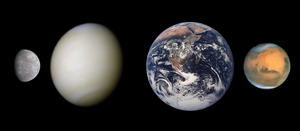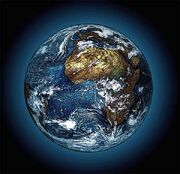Tag: sourceedit |
No edit summary |
||
| (One intermediate revision by one other user not shown) | |||
| Line 49: | Line 49: | ||
* [[Chthonian planet]] |
* [[Chthonian planet]] |
||
* [[Planetary habitability]] |
* [[Planetary habitability]] |
||
| − | * [[Terrestrial Parochialism]] |
||
==References== |
==References== |
||
| Line 64: | Line 63: | ||
{{Footer_SolarSystem}} |
{{Footer_SolarSystem}} |
||
| − | [[Category: |
+ | [[Category:Planetary science]] |
Latest revision as of 14:50, 2 July 2018
A terrestrial planet or telluric planet is a planet which is primarily composed of silicate rocks. The term is

The terrestrial planets Mercury, Venus, Earth and Mars in true colors, sizes to scale.
derived from the Latin word for Earth, "Terra", so an alternate definition would be that these are planets which are, in some notable fashion, "Earth-like". Terrestrial planets are substantially different from gas giants, which may not have solid surfaces and are composed mostly of some combination of hydrogen, helium, and water existing in various physical states. Terrestrial planets all have roughly the same structure: a central metallic core, mostly iron, with a surrounding silicate mantle. The Moon is similar, but lacks an iron core. Terrestrial planets have canyons, craters, mountains, and volcanoes. Terrestrial planets possess secondary atmospheres; atmospheres generated through internal vulcanism or comet impacts, as opposed to the gas giants, which possess primary atmospheres, atmospheres captured directly from the original solar nebula.
Earth's solar system has four terrestrial planets: Mercury, Venus, Earth and Mars. During the formation of the solar system, there were probably many more (planetesimals), but they have all merged with or been destroyed by the four remaining worlds in the solar nebula. Only one terrestrial planet, Earth, is known to have an active hydrosphere.
Extrasolar terrestrial planets
The majority of planets found outside our solar system to date have been gas giants, simply because gas giants are larger and therefore easier to see or infer from observation. How
ever, a number of extrasolar planets are known or suspected to be terrestrial.
The first terrestrial planets ever detected outside our solar system were detected by Aleksander Wolszczan orbiting the pulsar PSR B1257+12. Their masses being 0.02, 4.3, and 3.9 Earth masses. The planets were observed because their transit caused interruptions in the pulsar's radio emissions. Had they not been orbiting around a pulsar, they would never have been found.
When 51 Pegasi b, the first extrasolar planet found around a fusing star, was discovered, many astronomers assumed it must be a gigantic terrestrial, as it was assumed no gas giant could exist as close to its star (0.052 AU) as 51 Pegasi b did. However, subsequent measurements of its diameter confirmed it was a gas giant.
In June 2005, the first planet around a fusing star that is almost certainly terrestrial was found orbiting around the red dwarf star Gliese 876, 15 light years away. That planet has a mass between six and nine times that of earth and an orbital period of just two Earth days.
On 10 August, 2005, the international team Optical Gravitational Lensing Experiment spotted the signature
of a cold planet designated OGLE-2005-BLG-390Lb, about 5.5 times the mass of Earth, orbiting a star about 21,000 light years away in the constellation Scorpius. The planet revealed its existence through a technique known as gravitational microlensing, currently unique in its capability to detect cool planets with masses down to that of Earth.
In late 2005, the same team discovered the planet OGLE-2005-BLG-169Lb, which is 13 times the mass of Earth and orbiting a star approximately 9,000 light years away. This planet may be either a gas giant or terrestrial. The newly discovered planet orbits its parent star at a distance similar to that of our solar system's asteroid belt.
Theoretically, there are two types of terrestrial or rocky planets, one dominated by silicon compounds, as Earth is, and another dominated by carbon compounds, like carbonaceous chondrite asteroids. These are the silicate planets and carbon planets (or "diamond planets") respectively.

A view on Planet Earth (painting)
A number of telescopes capable of directly imaging extrasolar terrestrial planets are on the drawing board. These include the Terrestrial Planet Finder, Darwin (ESA), New Worlds Imager, and Overwhelmingly Large Telescope.
See also
- Jovian planet/Gas giant planet
- Chthonian planet
- Planetary habitability
References
- Found: one Earth-like planet Astronomers use gravity lensing to spot homely planets. By Mark Peplow, News @ Nature.com, 25 January 2006.
- Beaulieu J.P., et al. (2006) Nature, 439, 437-440.
- National Science Foundation press release "Closer to Home."
- A New Path to New Earths National Science Foundation webcast.
- Ogling Distant Stars National Science Foundation grant report.
- Wolszczan's Pulsar Planets.
- PLANET Homepage.
- RoboNet Homepage.
- OGLE Homepage.
- MOA Homepage.
| |||
|---|---|---|---|
| The Sun · Mercury · Venus · Earth · Mars · Ceres* · Jupiter · Saturn · Uranus · Neptune · Pluto* · Haumea* · Makemake* · Eris* · Dwarf Planet Candidates* | |||
| Planets · Dwarf Planets · Moons: Terran · Martian · Asteroidal
· Jovian · Saturnian · Uranian · Neptunian · Plutonian · Eridian | |||
| 'Ceres * Pluto * Haumea * Makemake * Eris | |||
| Small bodies: Meteoroids · Asteroids (Asteroid belt) · Centaurs · TNOs (Kuiper belt/Scattered disc) · Comets (Oort Cloud) | |||
| Hypothetical Bodies: Vulcan · Planet 9 · Planet 10 · Tyche · Nibiru · Nemesis · more... | |||
| Planets with '*' are dwarf planets. | |||
| See also astronomical objects and the solar system's list of objects, sorted by radius or mass. |